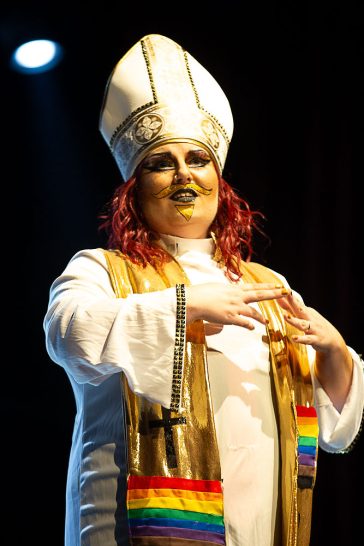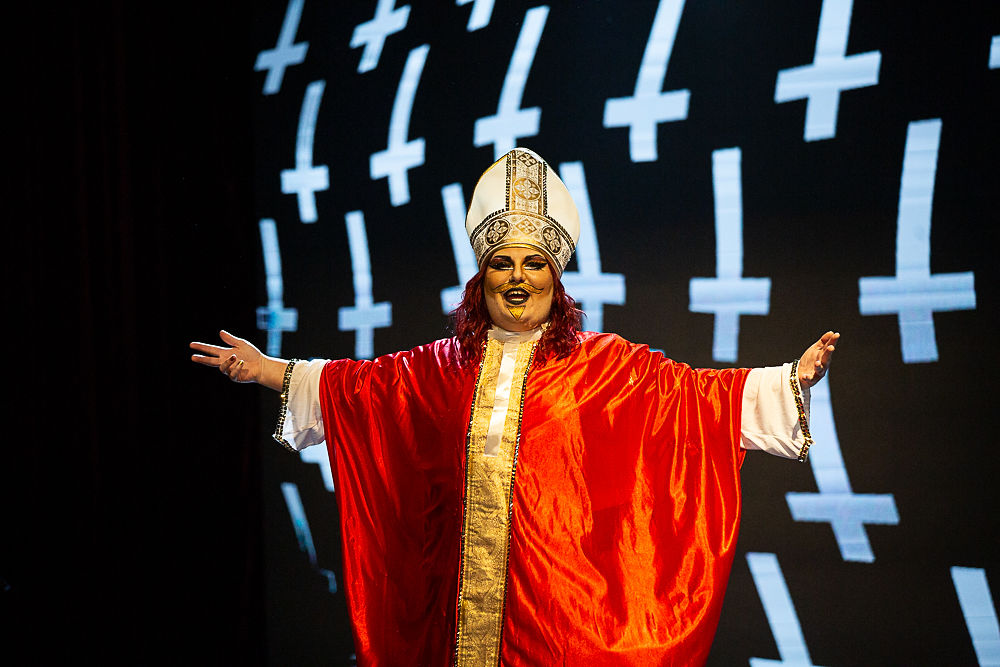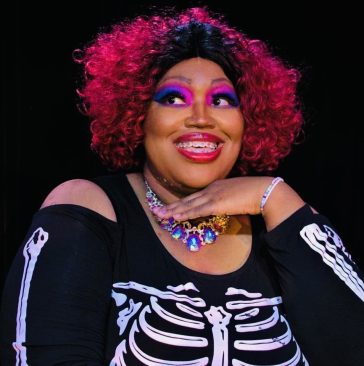Until I competed in my first pride pageant on May 28 at River City Casino, all I really knew about pageants came from watching the iconic 2006 film Little Miss Sunshine and occasionally mining YouTube for the worst beauty pageant responses to the on-stage Q&A. My working class roots and the fact that I was raised to scorn anything that could be deemed “frivolous” — manicures, bubble baths, fancy dresses — meant that I had suspicions and preconceived notions about what a pageant could be. But after stepping on stage at Prism for the weekly Rising Stars show on Sunday nights, I quickly learned that pageantry is a cornerstone of the contemporary drag scene — or at least the corner of it I had discovered.
Modeled after traditional beauty pageants for cisgender women, drag pageants involve a lot of fanfare, competition in several categories including fashion and talent, and a crowning ceremony. Mars, a local performer who had been crowned King of Pride in 2022, convinced me to send in an application for the Pride St. Louis pageant this year. His bartending job at Prism meant that he had a front row seat over the past year to watch my drag evolve. Every Sunday when I arrived for Prism’s up-and-comers show with an outrageous idea or costume, he would casually mention that pageants could be another place to showcase my creativity. The day I arrived with a giant skirt constructed out of pink paper giftbags, he told me, “You put more effort into these Rising Stars performances than most people do for entire pageants.”

The skirt that Fender Bender made out of sunglass lenses. | Shelby Baseler Photography
So I started asking questions. I learned that the Pride St. Louis Pageant at the end of May had been a tradition since 1990 — four years before I was born — and there were five categories of competition. Fundraising was the first and simplest: Every contestant had to raise at least $350 for Pride STL to receive maximum points in that category — anything raised above that would only be a tie breaker. The second category was a formal interview with the judges. The third and fourth categories were looks: The judges wanted to see our best eveningwear and a “presentation of pride” outfit. The fifth — and perhaps the most pivotal — was talent. We could do anything we wanted on stage as long as it was five minutes or less and didn’t involve nudity, live animals or loose glitter.
What cemented my decision to compete in the pageant was a new category that fit my style of drag perfectly: Mx. Pride. Because I delight in gender fuckery, in blending extreme markers of femininity and masculinity into one chaotic car wreck of a persona I call Fender Bender, I felt that I could authentically show up without choosing to be strictly male or female. Although this was the second year Pride STL advertised Mx. Pride as an option, no one had competed in the category the first year, so if I won, I would be the first-ever Mx. Pride.
After I paid my $25 application fee and submitted my paperwork, Mars called me, breathless. “I am so excited for you,” he said. “Now is when the real work begins.” And he was right. I had six weeks to prepare, and in that time, I learned how to sew, I met the fundraising goal and I sought help from a graphic designer friend who made an animation to accompany my talent number. My friend in cosmetology school offered to style my wig for eveningwear, so I provided her with a long, dark, lace front that vanished when her Kia was stolen two days before the pageant. She was able to procure another wig in a few hours and then styled it to perfection with voluminous curls and two coiled victory rolls characteristic of WWII-era women who modeled their hair after the exhaust rolls left by fighter pilots.

Gabe Montesanti competing as Fender Bender in the Pride St. Louis pageant. | Shelby Baseler Photography
The pageant was a 12-hour ordeal: We had to arrive for orientation at noon, and the show itself wouldn’t conclude until midnight. At orientation we toured the space, met the 11 other competitors and drew playing cards to determine the order in which we would interview and compete. I drew the queen card, which meant I would be second to last.
While the first six contestants lined up for their interviews, the second six did a sound check. I observed quietly while drag performers out of costume made their way on the stage for their dry runs. After a couple hours, I was summoned for my interview. Trixie LaRue, a local queen who had been competing and winning pageants for 15 years, ushered me in to a conference room, where five queer people were waiting to grill me for seven minutes.
I wasn’t wearing any makeup beyond a simple layer of concealer and some mascara, and I felt oddly naked presenting as my “regular self” when I entered. The blazer I had chosen to represent my business casual aesthetic felt both overly formal and not enough so.
“What does community mean to you?” one judge asked, and I described the family in St. Louis that I had curated in the absence of my biological family. “What is your proudest accomplishment?”
The more I spoke, the more the judges seemed to get an idea who I am: someone who was raised Catholic in a small town in Michigan, someone who was deeply closeted until the age of 18, and someone who resists the notion that the only people who succeed in pageants are those who spend the most money. I described how I had made and greatly embellished most of my costumes for this event, and while some judges would go on to write “looks cheap” in their critiques, others would applaud me for my resourcefulness.
About 350 people arrived to watch the pageant, and by the time it started at 7 p.m. sharp, we were all in face — meaning we had made ourselves up to look like kings or queens or — in my case — some version in between. First on the docket for the evening was to showcase our “presentation of pride” looks, and while many of the contestants opted for various rainbow-colored garb and gowns, some had taken a less literal approach.

Gabe Montesanti, a.k.a. Fender Bender, became St. Louis’ first Mx. Pride at the Pride St. Louis pageant. | Shelby Baseler Photography
Moxie Contin, who would go on to win the crown in Ms. Pride, wore fiery red four-foot hair horns that sprouted from her wig like beanstalks. I watched from behind the curtain as she took the stage and modeled her look, admiring the raw power with which she took the microphone and said, “Some people in this country demonize queer people. They’re stripping our rights. They think we belong in hell. Well, I say to that, if being queer makes you evil, then call me the devil!”
The audience erupted, and I felt chills spread down my arms and back. When it was my turn, I walked to center stage as the 1983 hit “Sunglasses at Night” played behind me.
“I constructed this look from 300 sunglass lenses,” I said into the microphone, and I turned so that the stage lights would reflect the hundreds of mirrored lenses adorning my skirt like fish scales. “Pride, to me, is about visibility. Being seen and seeing others. I see myself represented and reflected by all the queer people I’ve ever met, and I hope you see yourself reflected in me tonight. Literally.”
The crowd erupted again, and I sauntered back stage where my phone was blowing up with messages from my friends in the audience. I barely had time to read and absorb them, however: I had to get ready for talent. When it was my turn, “One of Us” by Joan Osborne started to play, and I emerged from the curtain in a pope costume.
“If God had a name, what would it be/ And would you call it to his face/ If you were faced with Him in all His glory/ What would you ask if you had just one question?”
The message I hoped to convey was essentially the title of the song: What if God were one of us — a person in this room — someone who was queer or an outcast with a thorny past who was now competing in a drag pageant? What if we were already holy?
For the final category, eveningwear, I wore a black and silver jumpsuit and half a skirt that was made of tulle that was so large I had to hold it out in a permanent curtsy when I walked just so the heels of my boots wouldn’t snag. There were no other contestants competing in the Mx. category, so I knew I would win. Earlier in my life, I would have regarded this fact with shame — accepted my crown but told myself that since I was the only contestant, I didn’t really deserve it. That thought was not in my head when I knelt for Mars to pin the crown into my wig.

All of the Pride St. Louis royalty. From let to right, Mx. Pride – Fender Bender, Mr. Pride – Tyson Cameron, Ms. Pride – Moxie Contin, King of Pride – Oliver Hugh, and Queen of Pride – Analyse Thropic. | The skirt that Gabe Montesanti made out of sunglass lenses. | Gabe Montesanti competing in the Pride St. Louis pageant. | Shelby Baseler Photography
Less than 24 hours after the pageant, I was back in drag for the Monday night show at Prism. No one told me that part of the gig that night would involve one of the show directors, Noah, asking an on-stage question. I had seen show hosts pop questions to pageant performers who were practicing or newly crowned, but I hadn’t anticipated it happening to me. Breathing heavily after a high-energy lip-synch, I blew a kiss to the crowd and began to leave the stage, but Noah gently grabbed my arm, handed me a microphone and gestured for me to take center stage.
His question was slow and pointed: “What are your goals for the next year?”
Unlike other members of the court who knew that part of winning a pageant meant having a clear and concise plan for their reign, I simply felt energy churn in my belly. I thought of the legislators who are stripping our rights, the many bills being passed through state governments that limit where and how we do drag and our access to gender-affirming care, and the violence that disproportionally affects the queer community, particularly trans women of color.
“My goal for this year is activism,” I said. Then, in a moment of unbridled boldness, “I want to fuck shit up. I want to represent those who are uncategorizable. I want to show them there’s room for us, too.”
The audience was quiet for a moment, and then broke out in applause. Mercifully, Noah didn’t ask any follow-up questions. I’m not sure what I would have said in the moment if he asked how exactly I will implement this plan. I still don’t entirely know.
What I do know is that I will have even more opportunities, both as a writer, a performer, and now a queer representative in the community, to confront the fact that queer people are in danger. I will continue to meet people who have been impacted by damaging legislation and work to educate those who might not otherwise know what we’re fighting for. I’ll continue learning myself, both from the queer people I meet and from other writers and activists. I’ll wear my skirt made of sunglass lenses and reflect everything I want to see in the world: a little bit of hope, some healthy anger, and a lot of love.

